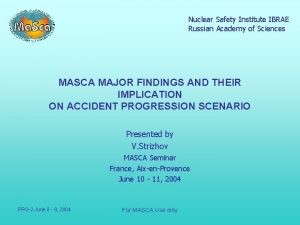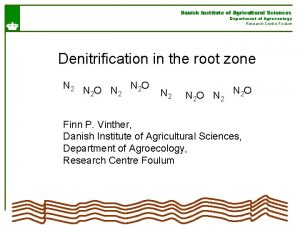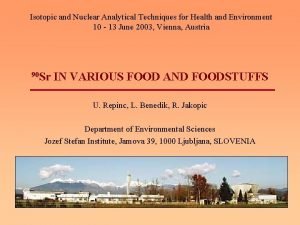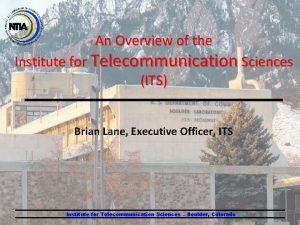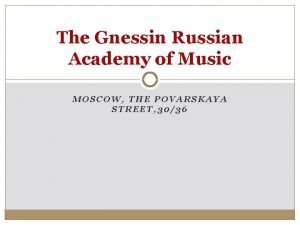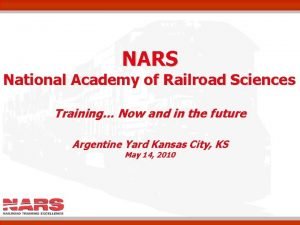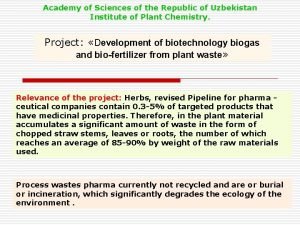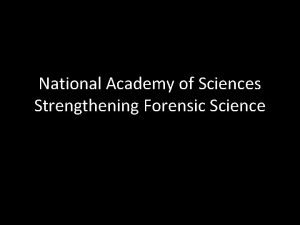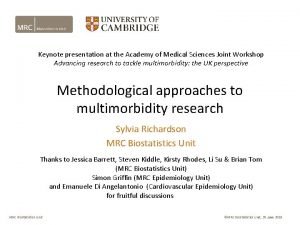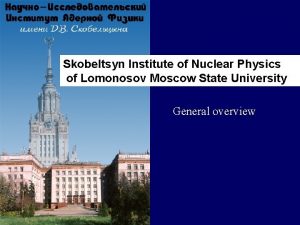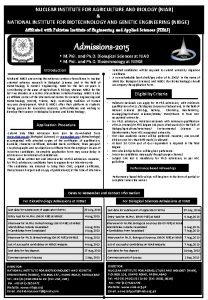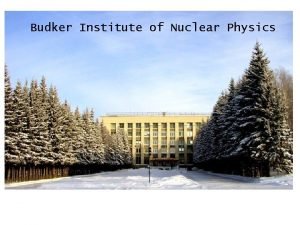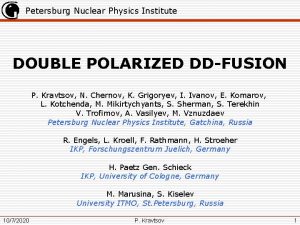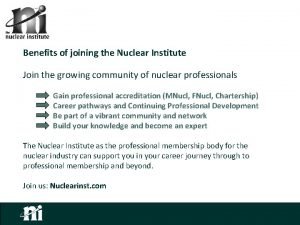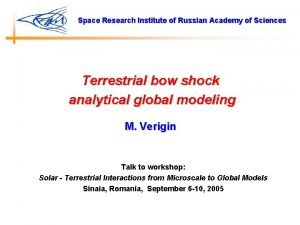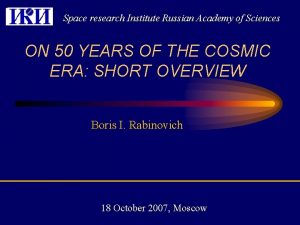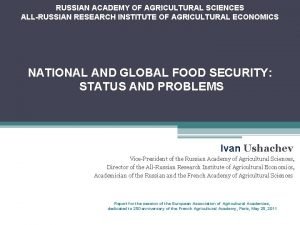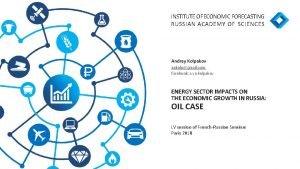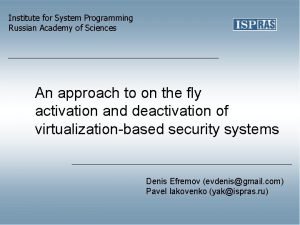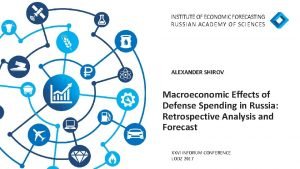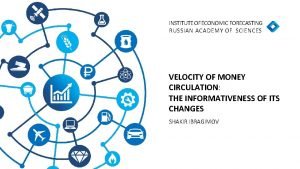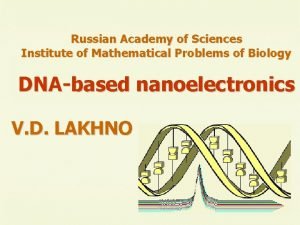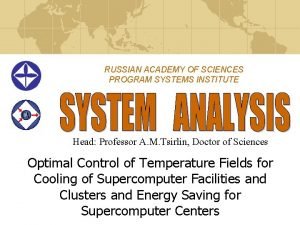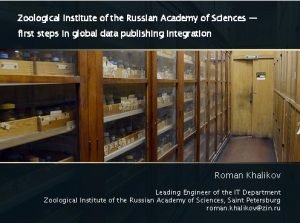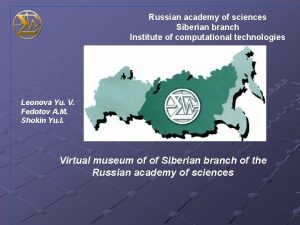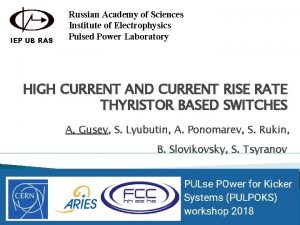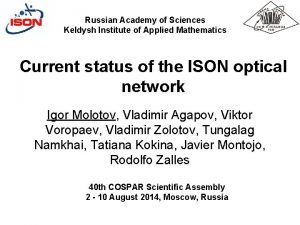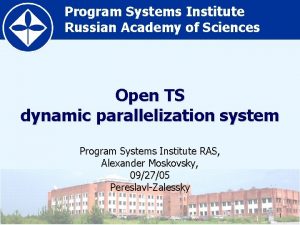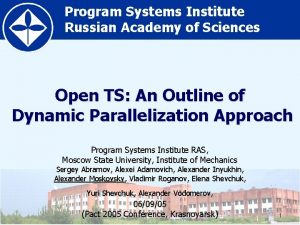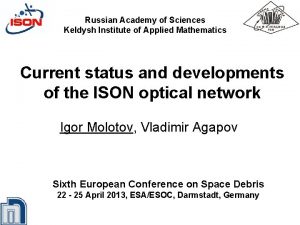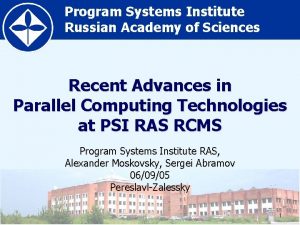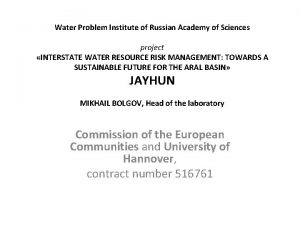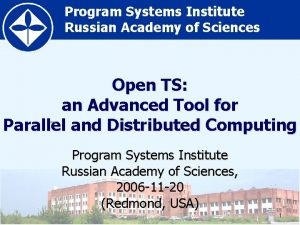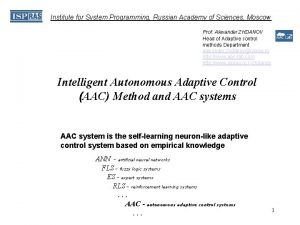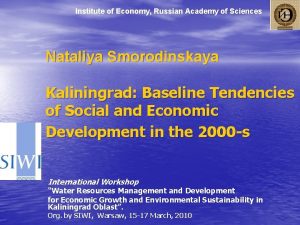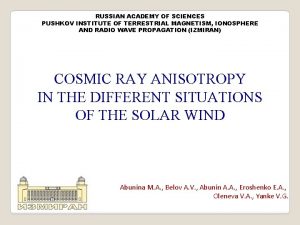Institute for Nuclear Research Russian Academy of Sciences
























- Slides: 24

Institute for Nuclear Research Russian Academy of Sciences Baksan Neutrino Observatory The search for neutrino bursts from supernovae with the Baksan Underground Scintillation Telescope (BUST) R. V. Novoseltseva for the BUST collaboration 2 -8 July 2017 11

7 BUST 1, 7 - LBL 2 - BUST 3 - Laser interferometer 4 - Acoustic gravitational antenna 5 - Geophysics laboratory 6 - GGNT (SAGE) 8 - ‘Andyrchy’ - for further projects * 8 2 -8 July 2017 22

dimensions 17 • 11 m 3 number of counters 3180 tank size - 70 • 30 cm 3 BUST – the general view (the effective depth 850 m of w. e. ) the scintillator Cn. H 2 n+2 (n ≈9) the total mass of scintillator – 330 t (3180 counters) A clock with a self–contained power provides 0. 2 ms accuracy of determining the absolute time. low-background concrete Iron layer (0. 8 cm) three lower horizontal layers (the inside -130 tons , 1200 counters – a detector D 1) 2 -8 July 2017 33

BUST: the upper plane 24*24 counters The information from each counter is transferred through three channels concurrently: 1) an anodic channel – measures of amplitude ( 6 Me. V - 2 Ge. V) and operation time of a scintillator layer 2) a pulse channel from 12 th dynode (12. 5 Me. V, 10 Me. V, 8 Me. V) 3) a channel from 5 th dynode has the energy threshold 500 Me. V a counter has a broad range of measurement – (8 Me. V – 600 Ge. V) The last essential change - the condition of event’s selection at the facility. Since March 2001 data recording is realized without exception. 2 -8 July 2017 44

≈73% - cosmic-ray muons (a muon -3 -4 planes, 1 - 2 counters at the plane) ≈8% - single events (the only counter at the telescope The triggers distribution (lines) fitted with a Gaussian (red curve) skewness=0. 38, kurtosis=4. 61 The count rate of triggers as a function of time. Each data point corresponds to one 15 -minutes RUN of BUST data. 06. 03. 2001 - 31. 12. 2014 (RUNs: 882815 – 1367520) 2 -8 July 2017 55

The Baksan experiment: the method If the mean antineutrino energy the range of e+ will be included, as a rule, in the volume of one counter. (The radiation length for our scintillator is 47 g/cm 2 ) The search for a neutrino burst consists in recording a cluster of single events within time interval of τ. We use a sliding time frame – from one event to the other (the clusters overlap). A t 2 -8 July 2017 66

The estimation of the expected number of events at BUST from ν burst 1)the distance to the star is 10 kpc 53 2) the total energy radiated in neutrinos is E=3 • 10 erg energy radiated in is (equipartitioned among all flavors) 3) we leave out a possible influence of oscillations • 1 – energy threshold 10 Me. V (1989 -1991 yr) • 2 – energy threshold 8 Me. V (since 1992 yr) E (Me. V) η 1 10 0. 7 20 0. 9 detection efficiency of e+ 7

• The registration of SN 1987 A has given rise to non-standard two-stage scenario of stellar collapse. The scenario has been proposed to incorporate both neutrino pulses from SN 1987 in a selfconsistent two-stage hydrodynamical model of the gravitational collapse. The mean neutrino energy (during the first stage) in this model is 3040 Me. V. Imshennik V. S. Space Sci. Rev. , 1995, 74: 325 Imshennik V. S. , Ryazhskaya O. G. Astronomy Letters, 2004, 30: 17 V. Bajkov, V. M. Suslin, V. M. Chechetkin, V. Bychkov, L. Stenflo, Astronomicheskij jurnal, 2007, 84(4): 308 This model has taken into account large-scale convection caused by nonequilibrium neutronization of matter in the central region of protoneutron star. The large-scale convection provides high yield of high energy neutrinos from the central region of presupernova. The average energy of neutrinos is 30 -50 Me. V which is more than in the case of diffusion. VALDAY 2015 2 -8 July 2017 88

Inverse -decay and additional reactions the total neutrino flux the reactions has distinctive signature: two signals separated with (1 -5)* time - a noticeable percentage of neutrino reactions will cause triggering of two counters simultaneously (count rate of two tanks ≈ 4 • 10 -3 s-1) If the scenario of 2 -stage collapse is realized in Nature, the total signal from collapse at the BUST, i. e. the number of neutrino induced events, increases by ≈ 50%. 29. 06. 17 2 -8 July 2017

Background events • radioactivity • ghost signals from a counter • cosmic ray muons: • a single muon is registered by one counter due to spatial gaps between counters of the telescope • a muon energy release < 8 Me. V • radioactivity: • natural radioactivity • Inelastic muon interaction with the matter of the counter. Some part of the background events can be connected with inelastic muon interactions which can produce unstable nuclei whose disintegration brings into operation only one counter. 2 -8 July 2017 10

fin = 0. 02 Hz - count rate of the inside (three lower horizontal layers) fout = 1. 43 Hz - count rate of the outside BUST, mean annual trigger count rate for three internal planes (130 tons of scintillator) and five external planes (200 tons) 2 -8 July 2017 11

Mean annual trigger count rate for three internal planes of the BUST (single events, target mass 130 tons of scintillator) March 2001 - data recording without exception 2 -8 July 2017 12

8 plane 7 plane 6 plane Peak in the region of 10– 15 Me. V is associated with the decay of cosmogeneous isotopes (12 B, 12 N, 8 B, 8 Li, etc. ) which are produced in the inelastic interactions of muons with the scintillator carbon and nuclei of the surrounding substance. 7 plane 8 plane 29. 06. 17 2 -8 July 2017

Background events can mimic expected signal according to (1) fin = 0. 02 Hz D 1, rate of background frequency f 1=0. 02 sec-1 ≈1/10 day k 1=6 ≈1/152 day k 1=7 ≈1/7. 27 year k 1=8 ≈1/145 year k 1=9 estimated The number of clusters with k single events within time interval of τ and - experimental data, the curves are the expected number according to the expression (1) (the sliding time frame), actual time T = 13. 67 yr (2001 – 2016 years) Distribution of 20 -sec clusters on multiplicity k (the clusters follow each other and do not overlap); the curve is the expected number according to the expression (P) 2 -8 July 2017 14 14

LVD in the INFN Gran Sasso National Laboratory (Italy), at the depth of 3600 m w. e. Large Volume Detector (LVD) The Large Volume Detector (LVD) consists of an array of 840 scintillator counters (in 3 towers), 1. 5 m 3 each, viewed from the top by three photomultipliers (PMTs). Each tower includes 280 counters. Total mass of scintillator – 1000 tns the same scintillator Cn. H 2 n+2 (n ≈9) , E. 15 15

We carried out a search for the coincidence of clusters in both facilities BUST and LVD. (It should be noticed, we treat background events certainly. ) The search for the cluster coincidence has been performed for two variants: 1)the search of clusters in LVD, which coincide with clusters in BUST and "inverse" task 2)the search of clusters in BUST, which coincide with clusters in LVD-BUST, 2012 -2014 years, coincidence of clusters 16

Scott M. Adams et al. 2 -8 July 2017 17 17

• Detectors D 1& D 2 can be used for increasing of the radius sensitivity of the BUST if one use them as independent coincidence detectors 1, 2, 3, 4, 5 planes – 1980 counters, 1. 4 sec-1 D 2 - 1012 counters (110 tons) , 0. 12 sec -1 2 -8 July 2017 18

RSN – a distance from the core collapse Supernova kν – mean value of number of neutrino events in the target (130 t) kν RSN 1 56. 6 2 40. 0 3 32. 7 4 28. 3 5 25. 3 6 23. 1 7 21. 4 8 20. 0 9 18. 9 D 1, rate of background frequency -1 f 1=0. 02 sec ≈1/10 day k 1=6 ≈1/152 day k 1=7 ≈1/7. 27 year k 1=8 ≈1/145 year k 1=9 To increase the radius of sensitivity of the BUST in the experiment of registration neutrino bursts from Supernova we have allocated an array of 1012 counters on external planes. This array from 1012 counters (weight of 110 tons) can be used as the second independent detector for registration neutrino events (Detector D 2). The count rate of the array is low enough – 0. 12 сек-1. 2 -8 July 2017 19

The algorithm of event selection - a candidate for neutrino burst: 1. Registration in detector D 1 in the sliding 20 -sec window a cluster with large multiplicity k 1 ν. 2. It is checked the 10 -sec window in detector D 2. The beginning of the 10 -sec window in D 2 coincides with the beginning of cluster in D 1, duration is reduced in 2 times (20 sec: 2) to reduce number of the background events Estimation of number of neutrino events in D 2: the relation of weights 110/130 = 0. 846 If an average value k 1ν=6 in D 1, an average value of neutrino events in D 2 k 2ν = 6*0. 846*0. 8 = 4. 06. (factor 0. 8 takes into account that the frame duration in D 2 is 10 seconds instead of 20 seconds in D 1). Event from background in D 2 - 0. 12*10= 1. 2 event → k 2 ν+b= k 2ν + 1. 2 = 5. 25 D 1, k 1ν =6 → D 2, k 2 ν+b = 5 or 6 f 1= 0. 02 sec -1, f 2=0. 123 sec-1, T=1 year Clusters - imitation by background Detectors D 1 and D 2 are independent. Then probability of imitation by background such event, when D 1 with cluster k 1, and D 2 - cluster k 2, is equal to product of probabilities of occurrence clusters k 1 and k 2 detectors D 1 and D 2 accordingly. P(6; 5)=P 1(6)*P 2(5) 2 -8 July 2017 D 2 D 1 k 2=5 k 2=6 k 1=5 3, 121 0, 641 k 1=6 0, 250 0, 051 k 1=7 0, 017 0, 003 k 1=8 0, 001 0, 000 20

f. D 2=0. 12 сек-1 BUST, mean annual trigger count rate for the detector D 1 (three internal planes, 130 tons of scintillator) and the detector D 2 (selection counters from five external planes, 110 tons) Distribution of 10 -sec clusters in D 2 on multiplicity k 2, (the clusters follow each other and do not overlap) - experimental data, the detector D 2; the curve is the expected number according to the expression (P) , actual T = 5. 3 yr (2011 – 2016 years) 2 -8 July 2017 21

N 1=3561976 events N 2=19904427 events k 1=4 , N=27513 k 1=5, N=2960 k 1=6, N=249 k 1=7, N=15 D 1 D 2 exp calc exp k 2=2 5815 5302 595 530 53 42 k 2=3 2325 2179 239 218 30 17 k 2=4 742 672 77 67 7 5, 4 k 2=5 186 166 15 17 2 1, 3 k 2=6 27 34 9 3, 5 0 0, 3 k 2=7 5 6 1 0, 6 0 0, 05 calc 3 1 2 0 0 3 1, 2 0, 4 0, 1 0, 02 In the table experimental data for 2011 -2016 years are resulted: number of clusters with k 1 in D 1 which are accompanied by not less than two events in D 2; the calculation number of events for T=5. 3 yr is shown. 2 -8 July 2017 22

Detection probability of clusters from neutrino burst with different multiplicity 2 -8 July 2017 23

CONCLUSIONS • • We have shown a long-term stability of the BUST operation. We carried out a search for the coincidence of clusters in two facilities - BUST and LVD. (It should be noticed, we treat background events certainly and the analysis has methodical character). The analysis of data of two and more facilities can be particularly useful in cases when optical SN is invisible on some reasons. To increase the sensitivity radius of the BUST, we use two parts of the BUST (D 1 and D 2 detectors) with the total mass of 240 tons (1200 counters and 1012 counters ). The radius of sensitivity of the BUST is ≈24 kps The cluster of events at the BUST would be considered to be a serious candidate for collapse detection if 6 or more single events were observed within 20 s sliding time interval in the detector D 1 and 5 single events in the detector D 2 simultaneously. live upper time bound year (years) (90% cl) 1983 2, 2 0, 33/yr 1993 11, 0 0, 21/yr 2000 17, 6 0, 13/yr 2014 29, 8 0, 077/yr 31. 12. 2016 31, 3 0, 074/yr 2 -8 July 2017 • No burst candidate for the core collapse has been detected during the observation period of June 30, 1980, to December 31, 2016. The actual observation time is 31. 27 years. This is the longest observation time of our Galaxy with neutrinos in the same facility. The limit on the mean frequency of collapses in the Milky Way fcol < 0. 074 year– 1 (90% C. L. ) 24 24
 Nuclear safety institute of the russian academy of sciences
Nuclear safety institute of the russian academy of sciences Natural sciences tok
Natural sciences tok Lesson 15 nuclear quest nuclear reactions
Lesson 15 nuclear quest nuclear reactions Fisión nuclear vs fision nuclear
Fisión nuclear vs fision nuclear Kavneet hayre
Kavneet hayre Danish institute of agricultural sciences
Danish institute of agricultural sciences Health and environmental sciences institute
Health and environmental sciences institute Institute for telecommunication sciences
Institute for telecommunication sciences Kafue institute of health sciences
Kafue institute of health sciences Kafue institute of health sciences
Kafue institute of health sciences Russian academy of music
Russian academy of music Hazleton area academy of sciences
Hazleton area academy of sciences Academy of motion picture arts and sciences benefits
Academy of motion picture arts and sciences benefits Railroad training school
Railroad training school Hawaii academy of arts and sciences
Hawaii academy of arts and sciences Putnam academy of arts and sciences
Putnam academy of arts and sciences Biogas disadvantages
Biogas disadvantages National academy of sciences forensic science
National academy of sciences forensic science Academy of medical sciences multimorbidity
Academy of medical sciences multimorbidity Cleveland arts & social sciences academy
Cleveland arts & social sciences academy Skobeltsyn institute of nuclear physics
Skobeltsyn institute of nuclear physics Nuclear institute for agriculture and biology
Nuclear institute for agriculture and biology Budker institute of nuclear physics
Budker institute of nuclear physics Petersburg nuclear physics institute
Petersburg nuclear physics institute Benefits of joining the institute
Benefits of joining the institute
